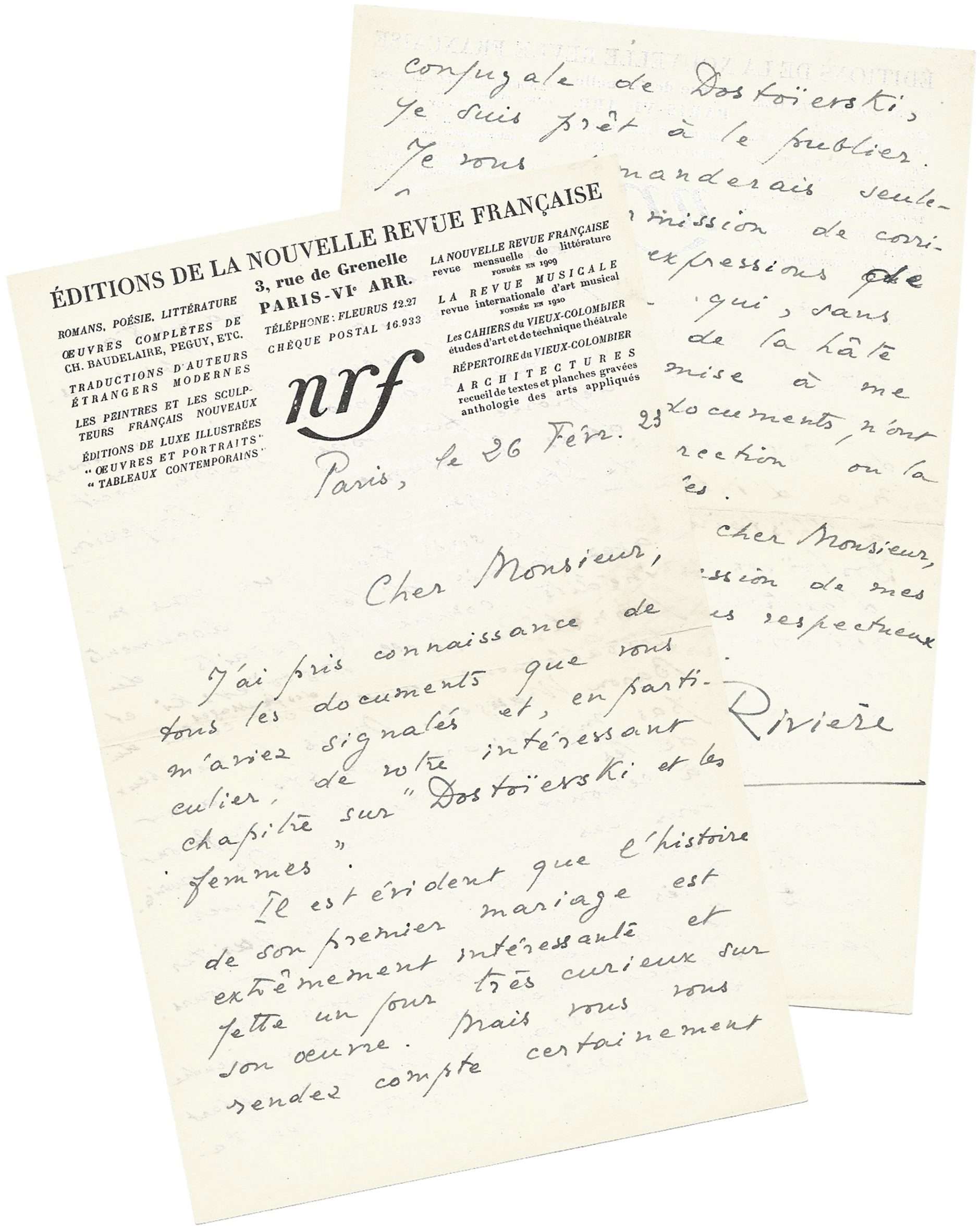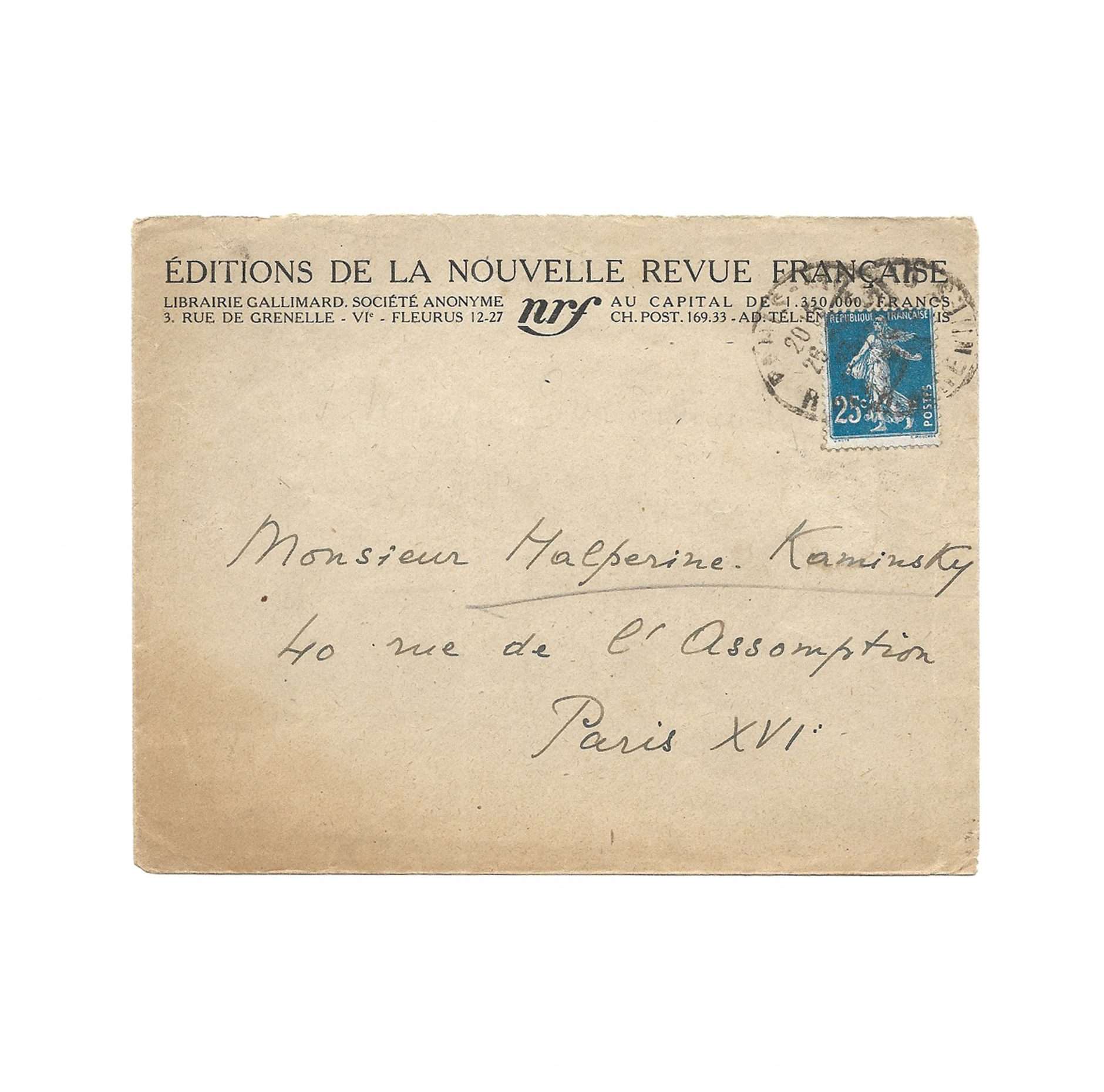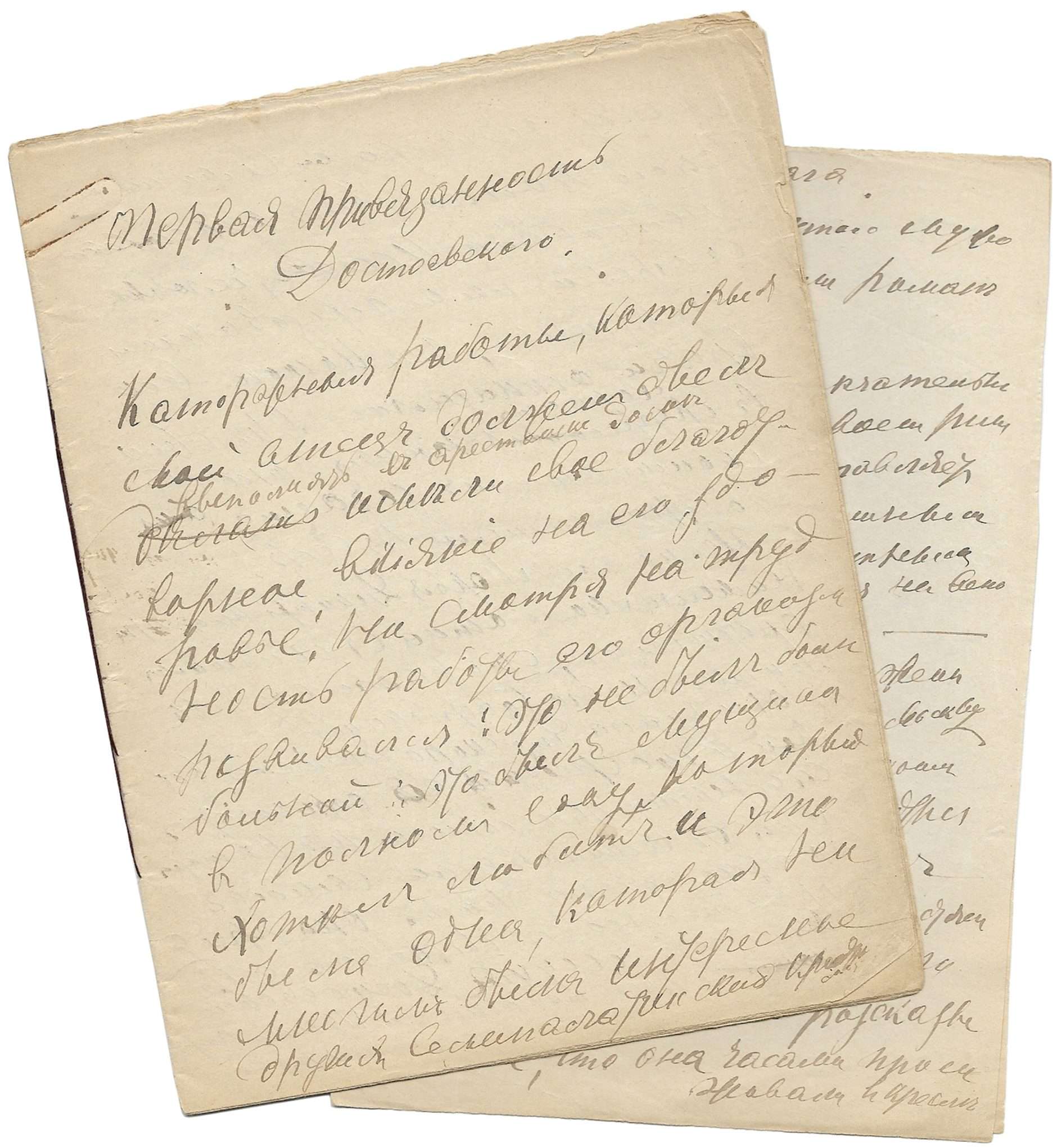[DOSTOEVSKY] RIVIÈRE, Jacques (1886-1925)
Autograph letter signed « Jacques Rivière » to Ely Halpérine-Kaminsky
Paris, 26 Feb. [19]23, 4 p. in-8°, NRF letterhead
« It is clear that the story of his first marriage is extremely interesting and sheds a very curious light on his work »
Fact sheet
[DOSTOEVSKY] RIVIÈRE, Jacques (1886-1925)
Autograph letter signed « Jacques Rivière » to Ely Halpérine-Kaminsky
Paris, 26 Feb. [19]23, 4 p. in-8°
Letterhead : “Éditions de la Nouvelle Revue Française”
Included: Autograph envelope, stamped and postmarked
A very interesting letter to one of the first translators of Dostoevsky into French
Concerning unpublished manuscripts and documents of the author during his shackling in the Omsk penal colony in Siberia
« Cher Monsieur,
J’ai pris connaissance de tous les documents que vous m’avez signalés et, en particulier, de votre intéressant chapitre sur “Dostoïevski et les femmes”.
Il est évident que l’histoire de son premier mariage est extrêmement intéressante et jette un jour très curieux sur son œuvre. Mais vous vous rendez compte certainement vous-même qu’en admettant qu’elle n’ait fait l’objet jusqu’ici d’aucune étude, elle se trouve néanmoins singulièrement déflorée par votre propre récit dans le volume de la Confession de Stavroguine¹.
Je sais bien que vous m’avez promis différents documents inédits, comme les extraits du journal de Melle Dostoïevski et probablement aussi des passages de celui du Baron Wrangel […]
Parmi les lettres en traduction manuscrite que vous m’avez communiquées, la lettre à Madame von Wizin[e] et très intéressante ; l’autre, de 1855, au Baron Wrangel, n’a d’intérêt que par rapport à l’histoire du mariage de Dostoïevski² […] En existe-t-il qui aient été adressées par D.[ostoïevski] à Mme Issaïer [toujours Maria Dmitrievna Dostoïevskaïa, épouse Issaieva de son premier mariage] avant leur mariage ?
Si nous arrivons à grouper un ensemble de documents inédits assez important pour éclairer toutes les faces de l’étrange situation conjugale de Dostoïevski, je suis prêt à le publier.
Je vous demanderai seulement la permission de corriger quelques expressions de votre traduction qui, sans doute à cause de la hâte que vous avez mise à me soumettre ces documents, n’ont pas toute la correction ou la netteté désirables.
Je vous prie, cher Monsieur, d’agréer l’expression de mes sentiments les plus respectueux et les plus dévoués.
Jacques Rivière »
Enclosed:
A manuscript by an unknown hand
N.p., n.d., 23 octavo pages, side-stitched (with a loose bifolium), in brown ink.
Written in pre-revolutionary Cyrillic script, the one used before the 1917 reform.
The manuscript corresponds to the ninth chapter of the memoirs of Liubov Fyodorovna Dostoevskaya about her father.
1/ The first translator of The Confession of Stavrogin, supplemented with an unpublished section of A Writer’s Diary, Halpérine-Kaminsky includes in it a lengthy preface on the discovery of the author’s unpublished fragment.
2/ A reference here to Dostoevsky’s first marriage, in the autumn of 1856, to Maria Dmitrievna, whose character traits and episodes of her biography are reflected in the writer’s work.
Rivière here lets certain nuances show through that might appear condescending. It should be recalled that Gide, leader of the NRF alongside Rivière, had just published his essay Dostoevsky in 1922, twenty years after Vogüé (who had introduced Russian literature to the French public). The latter, close to Halpérine-Kaminsky, did not enjoy Gide’s favor—quite the opposite. At the same time, the author of The Immoralist was contributing to the promotion of works by Lev Shestov and translations by Boris de Schloezer, no doubt to the detriment of Halpérine-Kaminsky. The publication project mentioned here by Rivière seems never to have come to fruition.
On the context of Dostoevsky’s first marriage, as mentioned by Rivière:
Dostoevsky met Maria Dmitrievna, the wife of a minor civil servant, Alexander Ivanovich Isaev, whom the writer had known since his release from the penal colony in early 1854. Believing he perceived signs of romantic interest, Dostoevsky sought to persuade the young woman to leave her husband and marry him. This came to pass the following year. The appointment of Baron Wrangel as prosecutor of Semipalatinsk (where Dostoevsky was stationed as an ordinary soldier) allowed the writer to greatly improve his circumstances. Curious about the development of the relationship between Fyodor Dostoevsky and Maria Dmitrievna, Wrangel noted that for Mrs. Isaev, it was more a matter of pity ‘for an unhappy man, lost in the storm,’ rather than a sincere feeling. For Fyodor Dostoevsky, however, he ‘had fallen in love with all the ardor of his youth.’
Their marriage lasted seven years. The character traits of Maria Dmitrievna Dostoevskaya and episodes of her biography are abundantly reflected in Dostoevsky’s work.
Translator of the works of Dostoevsky and Tolstoy, Ely Halpérine-Kaminsky (1858–1936) studied at the Faculty of Sciences in Paris, where he arrived in January 1880. In 1883 he founded the bilingual periodical Le Franco-russe, then worked as secretary for several newspapers. He is credited with the very first translation of The Brothers Karamazov in 1888, as well as The Confession of Stavrogin, translated in 1922.
Provenance:
P.E. collection





